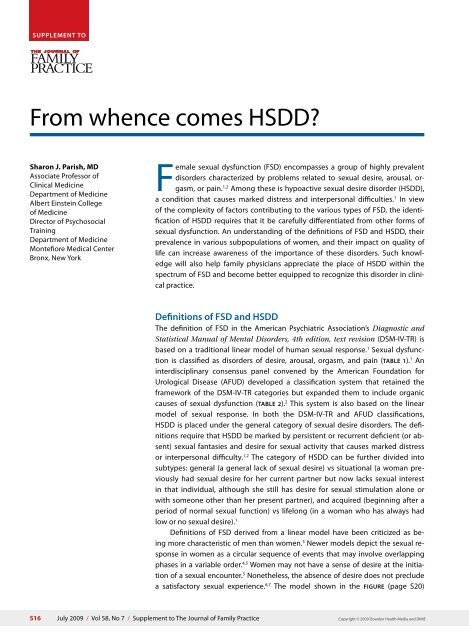S16 From whence comes HSDD? - The Journal of Family Practice
S16 From whence comes HSDD? - The Journal of Family Practice
S16 From whence comes HSDD? - The Journal of Family Practice
Create successful ePaper yourself
Turn your PDF publications into a flip-book with our unique Google optimized e-Paper software.
Supplement to<strong>From</strong> <strong>whence</strong> <strong>comes</strong> <strong>HSDD</strong>?Sharon J. Parish, MDAssociate Pr<strong>of</strong>essor <strong>of</strong>Clinical MedicineDepartment <strong>of</strong> MedicineAlbert Einstein College<strong>of</strong> MedicineDirector <strong>of</strong> PsychosocialTrainingDepartment <strong>of</strong> MedicineMontefiore Medical CenterBronx, New YorkFemale sexual dysfunction (FSD) encompasses a group <strong>of</strong> highly prevalentdisorders characterized by problems related to sexual desire, arousal, orgasm,or pain. 1,2 Among these is hypoactive sexual desire disorder (<strong>HSDD</strong>),a condition that causes marked distress and interpersonal difficulties. 1 In view<strong>of</strong> the complexity <strong>of</strong> factors contributing to the various types <strong>of</strong> FSD, the identification<strong>of</strong> <strong>HSDD</strong> requires that it be carefully differentiated from other forms <strong>of</strong>sexual dysfunction. An understanding <strong>of</strong> the definitions <strong>of</strong> FSD and <strong>HSDD</strong>, theirprevalence in various subpopulations <strong>of</strong> women, and their impact on quality <strong>of</strong>life can increase awareness <strong>of</strong> the importance <strong>of</strong> these disorders. Such knowledgewill also help family physicians appreciate the place <strong>of</strong> <strong>HSDD</strong> within thespectrum <strong>of</strong> FSD and become better equipped to recognize this disorder in clinicalpractice.Definitions <strong>of</strong> FSD and <strong>HSDD</strong><strong>The</strong> definition <strong>of</strong> FSD in the American Psychiatric Association’s Diagnostic andStatistical Manual <strong>of</strong> Mental Disorders, 4th edition, text revision (DSM-IV-TR) isbased on a traditional linear model <strong>of</strong> human sexual response. 1 Sexual dysfunctionis classified as disorders <strong>of</strong> desire, arousal, orgasm, and pain (Table 1). 1 Aninterdisciplinary consensus panel convened by the American Foundation forUrological Disease (AFUD) developed a classification system that retained theframework <strong>of</strong> the DSM-IV-TR categories but expanded them to include organiccauses <strong>of</strong> sexual dysfunction (Table 2). 2 This system is also based on the linearmodel <strong>of</strong> sexual response. In both the DSM-IV-TR and AFUD classifications,<strong>HSDD</strong> is placed under the general category <strong>of</strong> sexual desire disorders. <strong>The</strong> definitionsrequire that <strong>HSDD</strong> be marked by persistent or recurrent deficient (or absent)sexual fantasies and desire for sexual activity that causes marked distressor interpersonal difficulty. 1,2 <strong>The</strong> category <strong>of</strong> <strong>HSDD</strong> can be further divided intosubtypes: general (a general lack <strong>of</strong> sexual desire) vs situational (a woman previouslyhad sexual desire for her current partner but now lacks sexual interestin that individual, although she still has desire for sexual stimulation alone orwith someone other than her present partner), and acquired (beginning after aperiod <strong>of</strong> normal sexual function) vs lifelong (in a woman who has always hadlow or no sexual desire). 1Definitions <strong>of</strong> FSD derived from a linear model have been criticized as beingmore characteristic <strong>of</strong> men than women. 3 Newer models depict the sexual responsein women as a circular sequence <strong>of</strong> events that may involve overlappingphases in a variable order. 4,5 Women may not have a sense <strong>of</strong> desire at the initiation<strong>of</strong> a sexual encounter. 5 Nonetheless, the absence <strong>of</strong> desire does not precludea satisfactory sexual experience. 6,7 <strong>The</strong> model shown in the Figure (page S20)demonstrates that desire can be triggeredlater during a sexual experienceonce the woman has become subjectivelyaroused. 4,5<strong>The</strong> DSM-IV-TR definition <strong>of</strong><strong>HSDD</strong> has also been criticized becauseit considers sexual fantasies aprimary trigger for sexual behavior.Research has shown that spontaneoussexual thoughts or fantasies maybe characteristic <strong>of</strong> women in newrelationships but occur much lessfrequently among sexually healthywomen in longer-term relationships. 8Moreover, a woman’s desire for sexualactivity may be prompted by factorsnot addressed by current definitions,such as wanting to experience tendernessand appreciation by her partnerand feeling desirable. 9Since lack <strong>of</strong> sexual desire at thebeginning <strong>of</strong> a sexual encounter doesnot necessarily indicate <strong>HSDD</strong>, expertshave suggested that the definitionbe refined to indicate a recurrent,consistent lack <strong>of</strong> ability to experienceany desire or arousal. 5 Such criteriawould reflect the fact that desireproblems are usually associated withdifficulties in all phases <strong>of</strong> the sexualresponse cycle. For instance, orgasmcannot occur without arousal, and alack <strong>of</strong> arousal <strong>of</strong>ten results in a lack<strong>of</strong> desire because sexual activity isnot enjoyable. Sexual pain disordersand lack <strong>of</strong> sexual arousal may also belinked, as intercourse without arousaland associated lubrication can bepainful and lead to the avoidance <strong>of</strong>sexual activity.EpidemiologyTable 1FSDPrevalence estimates <strong>of</strong> FSD vary based on the patientpopulation and methodology employed. For example,age and age-group categorizations have differed amongmany studies, and inclusion criteria are <strong>of</strong>ten limited toDSM-IV-TR classification <strong>of</strong> female sexual dysfunction 1ClassificationSexual desire disordersHypoactive sexual desire disorderSexual aversion disorderSEXUAL AROUSAL DISORDERSFemale sexual arousal disorderORGASMIC DISORDERSFemale orgasmic disorderPAIN DISORDERSDyspareuniaVaginismusSymptomsAbsence or deficiency <strong>of</strong> sexual interest and/or desireAversion to and avoidance <strong>of</strong> genital contact witha sexual partnerInability to attain or maintain adequate lubricationswellingresponse <strong>of</strong> sexual excitementDelay in or absence <strong>of</strong> orgasm after a normal sexualexcitement phaseGenital pain associated with sexual intercourseInvoluntary contraction <strong>of</strong> the perineal muscles, preventingvaginal penetrationDSM-IV-TR, Diagnostic and Statistical Manual <strong>of</strong> Mental Disorders 4th edition, text revision.Table 2AFUD classification <strong>of</strong> female sexual dysfunction 2ClassificationSexual desire disordersHypoactive sexual desire disorderSexual aversion disorderSEXUAL AROUSAL DISORDERSFemale sexual arousal disorderORGASMIC DISORDERSFemale orgasmic disorderPAIN DISORDERSDyspareuniaVaginismusNoncoital painAFUD, American Foundation for Urological Disease.SymptomsAbsence <strong>of</strong> sexual fantasies, thoughts, and/or desire for,or receptivity to, sexual activity, which causes personaldistressPhobic aversion to and avoidance <strong>of</strong> sexual contact witha sexual partner, which causes personal distressInability to attain or maintain sufficient sexual excitement,causing personal distress, which may be expressed as a lack<strong>of</strong> subjective excitement, or genital (lubrication-swelling) orother somatic responsesDelay in or absence <strong>of</strong> attaining orgasm following sufficientsexual stimulation and arousal, which causes personaldistressGenital pain associated with sexual intercourseInvoluntary spasm <strong>of</strong> the musculature <strong>of</strong> the outer third<strong>of</strong> the vagina that interferes with vaginal penetration,which causes personal distressGenital pain induced by noncoital sexual stimulationwomen in sexual or stable relationships, omitting significantnumbers <strong>of</strong> women. Cultural differences, avoidance<strong>of</strong> a dialogue surrounding sexual complaints, and span<strong>of</strong> recall also may confound epidemiologic studies. 10 <strong>The</strong><strong>S16</strong> July 2009 / Vol 58, No 7 / Supplement to <strong>The</strong> <strong>Journal</strong> <strong>of</strong> <strong>Family</strong> <strong>Practice</strong> Copyright © 2009 Dowden Health Media and DIME www.jfponline.comSupplement to <strong>The</strong> <strong>Journal</strong> <strong>of</strong> <strong>Family</strong> <strong>Practice</strong> / Vol 58, No 7 / July 2009 S17
















